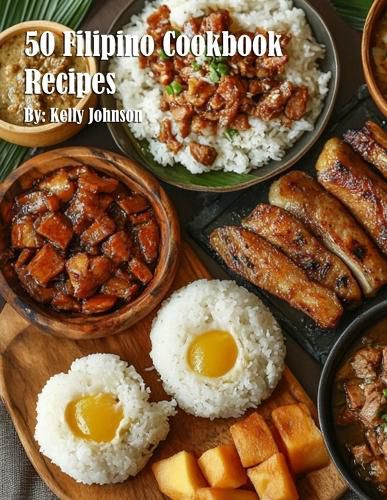Readings Newsletter
Become a Readings Member to make your shopping experience even easier.
Sign in or sign up for free!
You’re not far away from qualifying for FREE standard shipping within Australia
You’ve qualified for FREE standard shipping within Australia
The cart is loading…






This title is printed to order. This book may have been self-published. If so, we cannot guarantee the quality of the content. In the main most books will have gone through the editing process however some may not. We therefore suggest that you be aware of this before ordering this book. If in doubt check either the author or publisher’s details as we are unable to accept any returns unless they are faulty. Please contact us if you have any questions.
Filipino cuisine is a delightful mix of savory, sweet, and sour flavors, often featuring a variety of meats, seafood, and fresh vegetables. Classic dishes like adobo, a slow-cooked stew of chicken or pork marinated in vinegar, soy sauce, and spices, are staples in Filipino households. Sinigang is a tangy tamarind-based soup filled with vegetables and meats, often pork or shrimp, offering a refreshing contrast to the richness of other dishes. Lechon is a popular dish for special occasions, with a whole roasted pig cooked to crispy perfection. Pancit, a type of noodle dish, comes in many variations like pancit canton (stir-fried noodles) or pancit malabon (thick rice noodles with seafood). Kare-kare is a rich, savory stew made with oxtail, tripe, and vegetables, all coated in a thick peanut sauce, often paired with bagoong (fermented shrimp paste) on the side.
For lighter meals, laing is a coconut milk-based dish with dried taro leaves and chili, while bicol express offers a spicy combination of shrimp and pork cooked in coconut milk. Filipino breakfasts feature dishes like tocino (sweet cured pork), longganisa (Filipino sausage), and tapsilog (a combination of beef tapa, garlic rice, and a fried egg). Balut, a fertilized duck egg, is a unique Filipino delicacy, often enjoyed with salt and vinegar. Bibingka and puto are traditional Filipino rice cakes, often served during holidays or festivals. For dessert, halo-halo is a popular mixed dessert made of crushed ice, sweet beans, fruits, and leche flan, while turon is a sweet snack made of caramelized banana and jackfruit wrapped in spring roll wrappers. These dishes, with their bold flavors and diverse influences, provide a taste of Filipino culture in every bite.
$9.00 standard shipping within Australia
FREE standard shipping within Australia for orders over $100.00
Express & International shipping calculated at checkout
This title is printed to order. This book may have been self-published. If so, we cannot guarantee the quality of the content. In the main most books will have gone through the editing process however some may not. We therefore suggest that you be aware of this before ordering this book. If in doubt check either the author or publisher’s details as we are unable to accept any returns unless they are faulty. Please contact us if you have any questions.
Filipino cuisine is a delightful mix of savory, sweet, and sour flavors, often featuring a variety of meats, seafood, and fresh vegetables. Classic dishes like adobo, a slow-cooked stew of chicken or pork marinated in vinegar, soy sauce, and spices, are staples in Filipino households. Sinigang is a tangy tamarind-based soup filled with vegetables and meats, often pork or shrimp, offering a refreshing contrast to the richness of other dishes. Lechon is a popular dish for special occasions, with a whole roasted pig cooked to crispy perfection. Pancit, a type of noodle dish, comes in many variations like pancit canton (stir-fried noodles) or pancit malabon (thick rice noodles with seafood). Kare-kare is a rich, savory stew made with oxtail, tripe, and vegetables, all coated in a thick peanut sauce, often paired with bagoong (fermented shrimp paste) on the side.
For lighter meals, laing is a coconut milk-based dish with dried taro leaves and chili, while bicol express offers a spicy combination of shrimp and pork cooked in coconut milk. Filipino breakfasts feature dishes like tocino (sweet cured pork), longganisa (Filipino sausage), and tapsilog (a combination of beef tapa, garlic rice, and a fried egg). Balut, a fertilized duck egg, is a unique Filipino delicacy, often enjoyed with salt and vinegar. Bibingka and puto are traditional Filipino rice cakes, often served during holidays or festivals. For dessert, halo-halo is a popular mixed dessert made of crushed ice, sweet beans, fruits, and leche flan, while turon is a sweet snack made of caramelized banana and jackfruit wrapped in spring roll wrappers. These dishes, with their bold flavors and diverse influences, provide a taste of Filipino culture in every bite.